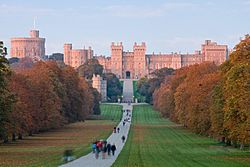Epiphany Rising facts for kids
Quick facts for kids Epiphany Rising |
|||||||
|---|---|---|---|---|---|---|---|
 Windsor Castle, where Henry IV stayed during the Epiphany rising |
|||||||
|
|||||||
| Belligerents | |||||||
| Rebel forces | |||||||
| Commanders and leaders | |||||||
The Epiphany Rising was a failed rebellion against King Henry IV of England in early January 1400. This uprising was an attempt to remove King Henry IV from the throne. The rebels wanted to bring back the previous king, Richard II.
Contents
Why the Rebellion Started
King Richard II's Rewards
Before Henry IV became king, King Richard II was on the throne. King Richard had given many important titles to people who supported him. These titles were like special rewards for their loyalty.
Henry IV Takes the Throne
In 1399, Henry IV took the crown from Richard II. This change in power meant big trouble for those who had been close to King Richard. Many of their new titles were taken away. This happened because they were seen as involved in the death of the Duke of Gloucester. Taking away titles and lands was called attainder.
The Secret Plan
Who Was Involved?
A group of powerful nobles decided to plan a rebellion. The main leaders were:
- John Montagu, 3rd Earl of Salisbury
- John Holland, 1st Earl of Huntingdon (who was Richard II's half-brother)
- Thomas Holland, 3rd Earl of Kent
- Thomas le Despenser, 4th Baron le Despencer
Other important people in the plot included Edward of Norwich, 1st Earl of Rutland, Ralph Lumley, 1st Baron Lumley, Sir Thomas Blount, and Sir Bernard Brocas.
The Meeting and the Plot
These conspirators met on December 17, 1399. They gathered at the Abbey house in Westminster. Their plan was to capture the new King Henry IV. They knew he would be at Windsor Castle for a special celebration called the feast of Epiphany.
They hoped to catch the king during a tournament. A tournament was a mock battle or contest. The rebels planned to kill King Henry and put Richard II back on the throne.
The Betrayal
However, their secret plan was discovered. Edward of Norwich told King Henry about the plot. Some historical records are not clear about Edward's exact role. But King Henry was warned.
Because he knew about the danger, King Henry did not go to Windsor. Instead, he started gathering an army in London. When Kent and Salisbury arrived at Windsor Castle with their 400 soldiers, they found the king was not there. They quickly left.
What Happened Next
Rebels on the Run
The conspirators had to flee to the western parts of England. They tried to start a larger rebellion there. However, they did not get much support from the local people. Soon, local authorities caught them.
Capture and Punishment
- While trying to take Cirencester, Lumley was killed in a fight with the townspeople.
- Salisbury and Kent were captured. They were quickly killed without a trial on January 7, 1400.
- Le Despenser was caught by a crowd in Bristol. He was also killed on January 13, 1400.
- Huntingdon was captured at Pleshey and killed on January 16, 1400.
- Blount escaped to Oxford. There, he faced a very harsh punishment on January 12, 1400.
- Brocas was caught in Cirencester and killed at Tyburn.
Aftermath for Families
After their deaths, the executed rebels had their titles and lands officially taken away. This happened in March. However, the brother of Kent and the sons of Salisbury and Huntingdon later got their family titles back. In 1461, a new parliament officially reversed these punishments.
The Fate of Richard II
The Epiphany Rising also made King Henry IV realize something important. As long as the former King Richard II was alive, he was a threat. Richard was imprisoned, but he could still inspire rebellions. Soon after the rising, Richard II died in Pontefract Castle. The exact cause of his death is still unknown.

